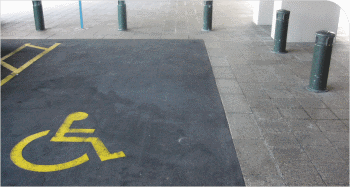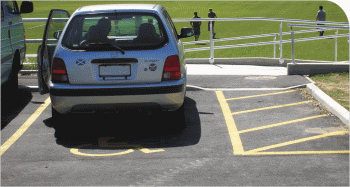Key features of an off-street accessible car park
NZS 4121 includes key features of an off-street accessible park as follows:
- size – the standard size for an accessible park is 3.5m x 5m
- slope – the slope should not be steeper than 1:50 in any direction
- surface – the best surfacing materials are tarmac or concrete. Other surfaces that have similar slip resistance could be acceptable, but only if they are stable and firm enough to support a wheelchair under all weather conditions
- location – the park should be as close to the building entrance as possible
- access – there must be an accessible route from the park to the building entrance. This means a route that can be easily and safely traversed by a wheelchair user without assistance, free of kerbs and other obstructions.

The paving is flush with the park making access easy.

The accessible route to the ramp is clearly defined, in relation to:
- safety – there should be no abrupt changes of gradient other than kerb ramps where needed. There should be no need to pass behind parked cars to reach an accessible park
- signs – the usual convention is to mark the park with yellow paint. The International Symbol of Access is applied to the surface of the park. Other signs indicate the direction to the park along the route from the street as well as the park itself
- ticket dispensers – a ticket dispenser or other device should be placed at a height of 1000-1100mm and not more than 200mm horizontally behind the kerb below.